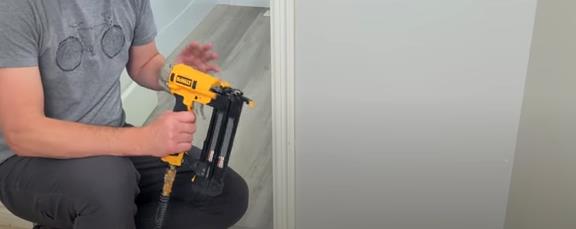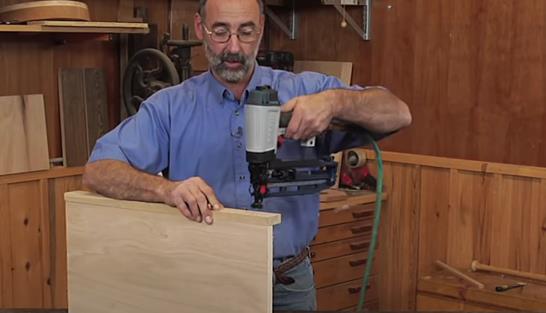The air pressure for a finish nailer is approximately 70–120 psi.
A finish nailer is a type of pneumatic nailer that is designed for finishing applications, such as trim work, baseboards, and cabinets.
Most of the time, the nails used in a finish nailer are much smaller than those used in a framing nailer, and the air pressure needed to drive them is lower as a result. But what Air Pressure For Finish Nailer?
The amount of air pressure needed to run a finish nailer depends on the model, but most of them need between 60 and 120 psi. Most finish nailers on the market today are made to work at 90 psi (pounds per square inch).
However, when it comes to finishing carpentry and woodworking, the air pressure in your finish nailer is a key element in achieving a professional and polished look.
With the right air pressure, the nails are driven into the right depth, making a strong, long-lasting hold without hurting the wood around them. Today, I’ll go over everything.
What Air Pressure For Finish Nailer?
The pressure will be listed in the operator’s manual. As a general rule of thumb, 70–100 psi is good for most applications.

The air pressure for a finish nailer refers to the amount of compressed air that is used to drive nails into wood. The best air pressure for a finish nailer depends on the tool and the nails that are being used.
For most finish nailers, the recommended air pressure is between 70 and 120 pounds per square inch (PSI). But it’s important to check the instructions from the manufacturer to find out what air pressure your finish nailer needs.
It is important to note that the air pressure can be adjusted on most finish nailers, allowing you to fine-tune the pressure to suit the specific task at hand.
Suppose, if you are working on a delicate project that requires precise nailing, you may want to use a lower air pressure to avoid damaging the wood.
On the other hand, if you are working on a project that requires a lot of power and force, you may want to use a higher air pressure to ensure that the nails are driven in securely.
Here is an example on what air pressure for finish nailer:
When working with a pine board, you should use an air pressure of 60 to 70 psi. If you are working with an oak board, you would want to use an air pressure between 80-100 psi.
Overall, choosing the right air pressure for your finish nailer is crucial to get professional results, so it’s important to experiment with different settings to find the perfect balance for your specific project and finish nailer.
What Are The Benefits Of Using A Finish Nailer?
Using a finish nailer is quicker and easier than using a hammer and nails.

When it comes to nailing things into place during a home improvement or construction project, a finish nailer is a great tool to have on hand.
Finish nailers are similar to a brad nailer but they are larger in size and can drive nails up to 2 inches in length. This makes them ideal for attaching trim, molding, and other decorative elements.
There are several benefits of using a finish nailer over a traditional hammer and nails, including:
Less Risk of Splitting Wood:
When you use a finish nailer, the nails are driven in at a slight angle. This helps to prevent the wood from splitting when the nails are driven in.
Faster Nailing:
A finish nailer can drive nails much faster than you can with a hammer. This is a huge time saver, especially if you have a lot of trim or molding to install.
More Precise Nailing:
Finish nailers have a guide that helps you keep the nails in a straight line. This is great for ensuring that your trim or molding is installed evenly.
Less Fatigue:
Because you don’t have to swing a hammer, using a finish nailer is less physically demanding. This can help you avoid fatigue, especially if you’re working on a large project.
If you’re working on a home improvement project that involves trimming or molding, a finish nailer is a great tool to have on hand. It can save you time and effort while helping you achieve a professional-looking result.
How Does A Finish Nailer Work?
A finish nailer is a tool that drives nails into wood.
A finish nailer is a specialized type of pneumatic nail gun that is designed for use with small to medium nails.
Finish nailers are available in both cordless and corded models and can be used for a variety of applications, such as trim work, cabinets, and molding.
Let’s check out how a finish nailer works.
When the trigger is pulled, the finish nailer fires a nail into the material. The nail is driven by a piston that is actuated by compressed air. The air pressure is typically around 70–120 PSI. Finish nailers can be used with a variety of nails, including brad nails, finish nails, and pin nails.
Finish nailers are a great tool for a variety of projects and can save a lot of time and effort. If you’re doing any type of trim work, molding, or cabinetry, a finish nailer is a great tool to have in your arsenal.
How Do I Choose The Right Air Pressure For My Finish Nailer?
To choose the right air pressure for a finish nailer, check the owner’s manual to see what range of pressure is recommended, then adjust the pressure to fit that range.

Choosing the right air pressure for your finish nailer is important to make sure your nails go into the wood properly and to keep the wood from getting damaged.
Here are some tips on how to choose the right air pressure:
Check the manufacturer’s recommendations
The manufacturer of your finish nailer will have specific recommendations on the air pressure that should be used. These recommendations are based on tests that they have conducted and are the best guide to follow.
Consider the type of wood you’re working with
Softer woods will require less air pressure than harder woods. A finish nailer uses compressed air to drive nails into wood or other materials.
The air compressor provides the power for the finish nailer and is connected to the nailer via a hose. The finish nailer has a magazine that holds the nails, and a trigger that is used to fire the nails.
Use the lowest air pressure
Use the lowest air pressure that will get the job done. Using too much air pressure can damage the wood and make it more difficult to drive the nails in.
Experiment
If you’re unsure of what air pressure to use, start with lower pressure and increase it until you find the setting that works best for you.
Check for leaks
If you notice that your finish nailer is leaking air, it’s a good idea to reduce the air pressure. A leaky nailer can damage the wood and make it more difficult to drive the nails in.
Following these tips will help you choose the right air pressure for your finish nailer and avoid damaging the wood.
FAQ-What Air Pressure For Finish Nailer
What Are Some Tips For Using A Finish Nailer?
Here are some tips for using a finish nailer:
1. Always use the correct size nails for your finish nailer. Using the wrong size nails can damage the finish nailer and the wood.
2. Make sure the nails you are using are compatible with the finish nailer. Some finish nailers require special nails, so be sure to check before using.
3. Always use a nail that is long enough to penetrate the wood and the finish nailer’s baseplate. Using a nail that is too short can cause the finish nailer to jam.
4. When driving nails into wood, be sure to hold the finish nailer at a 90 degree angle. This will ensure that the nails are driven straight into the wood.
5. Be careful not to overdrive the nails. This can damage the wood and the finish nailer.
How Can I Troubleshoot My Finish Nailer If It’s Not Working Properly?
How Do I Clean My Finish Nailer?
What Are Some Safety Tips To Follow When Using A Finish Nailer?
Final Thought
Getting professional-looking results from your finish nailer requires that you choose the right air pressure. A range of 70–120 PSI is generally recommended for most finish nailers, but it’s important to consult the manufacturer’s instructions for specific recommendations.
By adjusting the air pressure to the correct setting, you can ensure that your nails are driven into the wood at the right depth, without causing any damage to the surrounding material. With the right air pressure, you’ll be able to achieve a flawless finish on all your projects, every time.
However, the ideal air pressure for a finish nailer will vary depending on the specific make and model of the nailer, as well as the type of finish nails being used.
I hope that you get a proper answer on what air pressure for finish nailer. If you have any further questions, please feel free to leave a comment below.


5 thoughts on “What Air Pressure For Finish Nailer: Know The Master Guide”
Comments are closed.